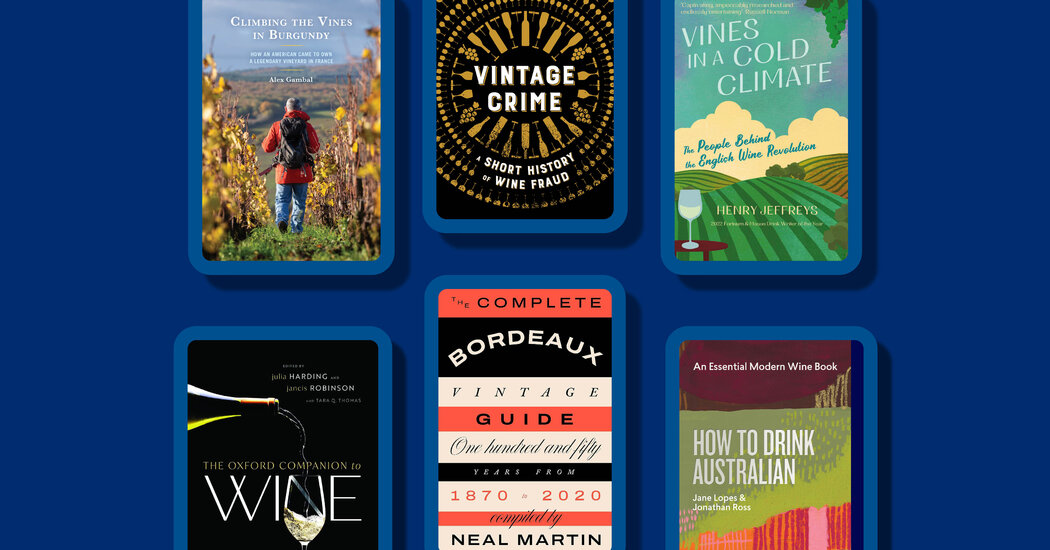
Like the annual grape harvest, each year brings a crop of provocative, entertaining and educational wine books. Here are four of the year’s best, along with a couple more well worth noting.
“How to Drink Australian” by Jane Lopes & Jonathan Ross (Murdoch Books, $60)
This book from the American sommeliers Jane Lopes and Jonathan Ross manages the neat trick of offering all the geeky information of geology, geography, climate and history sought out by students while giving ordinary wine-lovers what they crave: names of producers to seek out, whether mainstream names or the vanguard wineries that, to me at least, have made Australian wine so interesting.
Strikingly, they acknowledge front and center the deeply complex histories and cultures of the native peoples of Australia, pointing out the many ways in which these cultures lived in harmony with nature and the land, ways in which the colonizers, after more than two centuries, are only now beginning to understand and accept.
“Vines in a Cold Climate: The People Behind the English Wine Revolution” by Henry Jeffreys (Atlantic Books, $28)
The rise of English wine has been a fascinating story over the course of the last 40 years or so. But what exactly is English wine?
English sparkling wines are sold in American stores and featured on wine lists. Where did they come from? Are they any good? I can answer the second question: Yes, absolutely, if chosen carefully, as with any region.
As for the first question, Mr. Jeffreys, an English drinks writer, has done an excellent job of telling the story of the quirky characters and visionaries behind the first wave of modern English wines in the 1980s and ’90s. With tastes of success in the 1990s came both increasing professionalism in the business and new educational opportunities at Plumpton College, which established a winemaking curriculum that seems to have drawn every English wine professional.
Mr. Jeffreys is an engaging writer who is not so wed to a triumphal narrative that he’s afraid of asking impertinent questions, like, is this wine any good? Or is it just good for England? Nor does he shy away from the immense role played by climate change. And, while sparkling wine is a natural first step in a cold climate like England’s, he is cautiously optimistic that several English winemakers will succeed with still wines like chardonnay and pinot noir.
“Vintage Crime: A Short History of Wine Fraud” by Rebecca Gibb (University of California Press, $30)
As long as we have had wine, we have had wine adulteration, deception, “amelioration” and outright skulduggery. This slim yet insightful and entertaining volume documents the many instances where wine drinkers did not get what they paid for, sometimes with deadly consequences.
In ancient Rome, wines were laden with herbs, spices and other substances to make them palatable. In the 19th century, French merchants added robust reds from Italy or Africa to thin vintages for similar reasons, to make them more agreeable to consumers. Lead was added to sweeten wines in the 17th and 18th centuries. As recently as the late 20th century, people have died of drinking wine adulterated with methanol or antifreeze.
More recent examples have aimed to separate billionaires from their money, less deadly but in some ways more intriguing for the questions raised about the limits of connoisseurship.
What exactly constitutes fraud? Would that include overcropping, or appellations greedily extending their borders for profits, even if the logic of the appellation is lost? What about the modern deception of technological manipulation in the winery for a beverage passed off as a relatively natural pleasure? Ms. Gibb doesn’t answer definitively, but raising the question makes us think.
“Climbing the Vines in Burgundy: How an American Came to Own a Legendary Vineyard in France” by Alex Gambal (Hamilton Books, $25)
Alex Gambal was leading a successful family business in the Washington, D.C., area in the late 1980s when he became smitten by wine. So ensued an early midlife crisis that resulted in Mr. Gambal, his wife and children moving to Burgundy to experience life in France, first as a wine broker’s intern, then as a wine student. He subsequently built the wine estate of his dreams, but practically exhausted himself trying to make it work.
This book documents that experience. It’s an engrossing story that, unlike similar books, focuses not on the romance of vineyards and winemaking, but on the gears and grease of creating and maintaining a business without a vast reserve of wealth in perhaps the world’s most storied wine region.
Others Worth Noting
“The Oxford Companion to Wine,” edited by Julia Harding and Jancis Robinson with Tara Q. Thomas (Oxford University Press, $65), is the essential book for serious wine students. The new fifth edition covers much new ground since the last edition was published in 2015, including the effects of climate change, emerging wine regions and new scientific and historical insights.
“The Complete Bordeaux Vintage Guide: 150 Years From 1870 to 2020,” by Neal Martin (Quadrille, $45), is what every Bordeaux lover has been waiting for. Mr. Martin, a wine critic with Vinous.com, puts each vintage and decade in historical and cultural context. He is cheeky yet deeply knowledgeable, dispensing with formalities but getting to the heart of things.
Follow New York Times Cooking on Instagram, Facebook, YouTube, TikTok and Pinterest. Get regular updates from New York Times Cooking, with recipe suggestions, cooking tips and shopping advice.



